Overview
The TIBCO EBX® Information Governance Add-on provides a "governance repository" to manage the metadata applied to any assets registered with TIBCO EBX® (tables, fields, groups of fields, data types, workflows, rule). These assets can be master data that is under the control of the MDM system or any data managed by other applications.
The repository relies on the ISO-IEC 11179 standard (Information technology - Metadata registries MDR) that defines a robust data structure for collecting and sharing the knowledge applied to any data. It also provides a standard vocabulary defining key concepts that a metadata repository must apply. This means that the knowledge collected in the "governance repository" is independent of the tool. In this user guide, the term 'ISO' refers to the 'ISO-IEC 11179' standard.
Since the governance repository is built using EBX®, it benefits from the MDM features to govern the metadata as real master data. It provides:
UI for authoring the metadata,
Search functions based on formal criteria or fuzzy search,
Automatic creation of data hierarchy views based on the association between the data,
Permissions management,
History of all operations applied to the data,
Collaborative workflows to build governance processes,
Version management using data spaces,
Integration via Java API,
Export/import of XML, CSV, Excel, etc.
The governance repository uses three innovative functions to improve metadata quality:
The add-on automatically generates a 'Logical name' for new elements entered into the repository. This name is based on the underlying data model loaded into EBX®. This means that the logical name is related to the logical layer of data management. This name is inherited by another field known as the 'universal name' which can be changed by the repository administrator. The 'universal name' is related to the semantic layer of data management. Using this type of two-level naming approach ensures a clear relation between the logical and semantic data layers.
A de-duplication process can be executed when new information is entered into the repository. If elements are duplicated, a shared definition of the related metadata can be defined.
At any time, the relations between the logical layer (data models, workflow, rules) and the semantic layer (governance repository) are synchronized through a user service.
Based on EBX® permission management, any type of user profile can be created with rights that are specifically suited to organizational requirements. The following profiles are often required: Administrator, Data Owner, Data Account, User.
Online help
A tool tip link is available at the 'EBX® Information Governance Add-on' level as highlighted below. This link allows you to view the current user guide in PDF format.

Special notation key
Special notation key: | |
|---|---|
| Important recommendation for the use of the add-on. |
| This feature is not yet available in the current release. |